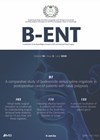
Journal Reviews
Hearing outcomes after mastoid obliteration tympanoplasty
In this study, the authors retrospectively compare hearing outcomes after mastoid obliteration to non-obliterative techniques in cholesteatoma surgery. They have performed canal wall up with mastoid obliteration (bony obliteration tympanoplasty or BOT) since 2013. The procedure has replaced canal wall...
Immunosuppresants and ototoxicity
There is a wide range of immunosuppressant drugs ranging from calcineurin inhibitors (e.g. cyclosporine), anti-folic agents (e.g. methotrexate) to anti-TNF and monoclonal antibodies, many of which could be ototoxic. The authors performed a systematic review assessing ototoxicity secondary to immunosuppressant...
Role of non-echo planar diffusion weighted magnetic resonance imaging in detection of cholesteatoma
Whilst the method of canal wall down and same-session reconstruction is emerging to be more popular, canal wall up procedures are still performed. In either, it is necessary to ensure eradication of cholesteatoma or detect its recurrence. The reliability of...
Effect of age-related changes in voice production and hearing on Voice Handicap Index and Geriatric Depression Scores
The ageing process affects hearing and production of voice. It is not unknown that impairment of these faculties can affect quality of life and also cause depression. The authors have presented an array of actual anatomical and functional changes that...
Biologics for deafness
Cochlear implants and hearing aids are inherently limited in their ability to restore ‘natural’ hearing. Biological therapy to treat inner ear pathology still is evolving rapidly with several ongoing clinical trials, though none are available for clinical practice to date....
Early results of the Cochlear Osia (active transcutaneous bone-conduction implant) in teenagers
This funded research trial involving 14 adolescents, aged 10 to 17 years, in the Toronto Hospital for Sick Kids was carried out just prior to the new Osia implant obtaining FDA approval for use in the USA. The majority had...
Complications associated with intra-tympanic steroid injections for sudden sensorineural hearing loss
Around 15,000 people in the UK experience a sudden sensorineural hearing loss (SSNHL) each year, and in the majority of cases the cause is unknown. Treatment options for idiopathic SSNHL include various modalities of steroid treatments which have known limitations...
Impact of delaying otologic surgery
In this Belgian study, the authors looked at the impact of delaying otologic surgery by sending an online survey to 44 adult patients diagnosed with benign ear pathology whose surgery was postponed due to the COVID-19 pandemic. The questionnaire was...
How can we manage children with poor speech discrimination but with normal audiogram
We often come across children and young adults brought in for consultation for suspected hearing loss and having hearing difficulty in noisy backgrounds but who often have normal audiograms. Such patients are suspected to have auditory neuropathy. The term auditory...
Does vestibular rehabilitation help patients with vestibular migraine? Is this also true if these patients have had a traumatic brain injury?
Vestibular migraine (VM) is a common diagnosis in ENT, and there is growing evidence that vestibular rehabilitation therapy (VRT) is an effective treatment, reducing self-perceived dizziness and improving gait. This is a retrospective review of the outcomes of 93 patients...
Asymmetrical hearing loss following prolonged occupational noise exposure
Noise-induced hearing loss (NIHL) is one of the commonest occupational conditions and has been linked with increased risk of work-related injuries. Noise-induced hearing loss is traditionally associated with bilateral symmetrical sensorineural hearing loss unless they are exposed to unilateral noises,...
Clinical Practice Guideline on Tympanostomy Tube in Children Update (AAO-HNS)
The American Academy of Otolaryngology–Head and Neck Surgery Foundation’s ‘Clinical Practice Guideline: Tympanostomy Tubes in Children (Update)’ has been recently published - an update of the original 2013 guideline. This article forms an executive summary to accompany the full guideline....















